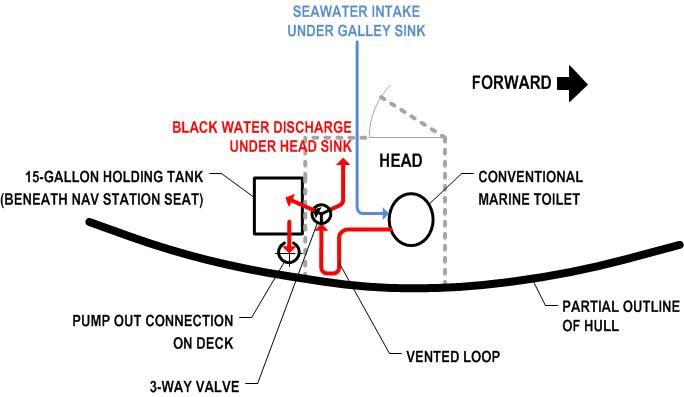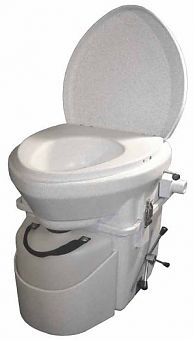Composting Toilet: Part 1
--Blog post written by Bob
According to Wikipedia, "A composting toilet is a dry toilet that uses a predominantly aerobic processing system that treats excreta, typically with no water or small volumes of flush water, via composting or managed aerobic decomposition. Composting toilets may be used as an alternative to flush toilets in situations where there is no suitable water supply or waste treatment facility available or to capture nutrients in human excreta as humanure. They are in use in many of the roadside facilities in Sweden and in national parks in both the United States and the United Kingdom.
The human excrement is normally mixed with sawdust, coconut coir or peat moss to support aerobic processing, absorb liquids, and to reduce the odor. The decomposition process is generally faster than the anaerobic decomposition used in wet sewage treatment systems such as septic tanks."
I understand that vacation homes on remote islands in the Great Lakes and cabins on mountain tops typically use composting toilets.
On a Cruising Sailboat?
The conversion to a composting toilet has been made on many cruising sailboats. A composting toilet (for a sailboat) actually separates liquid wastes from solid wastes--each goes into separate containers. There is no water used for flushing. The liquid wastes can be easily disposed from the urine container because there is very little environmental danger from urine. The solid wastes go into a separate container with peat moss (available almost anywhere). A trap door type valve allows the solid wastes to drop from the toilet bowl into the solid waste container. After each use, a handle is turned on the outside of the toilet that mixes the solid wastes with the peat moss inside the solid waste container. A small fan runs constantly and this air circulation continually removes moisture from the solid wastes. In this sense, it is actually a desiccating toilet, rather than a true composting toilet.
Our Conventional Marine Toilet
For the 27 years I've owned S/V Rainy Days I've had a conventional marine toilet. The conventional marine toilet brings in salt water for flushing. The liquid and solid wastes are flushed together into a 15-gallon holding tank. For two people, the holding tank fills up in about 3 to 4 days of full time use and then it must be pumped out at a marina--most of the volume is actually salt water brought in for flushing. Each pump out usually costs $5. Some boaters use a service where their holding tank is pumped out in the middle of the week to save them valuable sailing time on weekends--this service typically costs $50 per month.
 |
Plan View of Head Area on S/V Rainy Days |
S/V Rainy Days has a lockable y-valve that is capable of directing the waste stream into the holding tank (normal position for within the U.S.) or overboard (normal position outside the U.S.) The USCG routinely fines boaters whose y-valve is not locked in the correct position. (In a previous blog post, I described the addition of a "lockable" y-valve to meet these newer requirements.)
The State of Georgia has recently outlawed y-valves altogether (at least for inland waterways). While laws in the U.S. are becoming more restrictive, pump out facilities outside the U.S. are still not sufficient to support cruising sailboats. Therefore, it is becoming increasingly difficult for a cruising sailboat to cruise in the U.S. and the Bahamas without a zero discharge head.
While there are a few in-line waste treatment systems available (such as LectraSan), they don't meet the requirements for most harbor areas--most U.S. harbors are classed as "no discharge" zones. As a boat leaves U.S. waters, overboard discharge of liquid and solid wastes is legally permitted.
 |
Nature's Head Composting Toilet |
Advantages of Composting Toilet
(1) Solid waste disposal can be done less frequently (every 4 to 6 weeks of full time use).
(2) The solid waste to be disposed is like common soil--it can be used as soil or disposed of as yard wastes.
(3) No more odors from salt water sitting in the toilet bowl all week!
(4) The space taken by a 15-gallon holding tank can now be used for another purpose (like an auxiliary diesel tank!)
(5) Saves $5 to $10 per week in pump out costs while in U.S. waters.
(6) No more odor from head plumbing!
(7) No more hand pumping for flushing and waking up your mate in the middle of the night!
(8) No more marine toilet rebuilds and other stinky plumbing jobs on the boat!
(9) The space taken up by all the toilet-related plumbing under the sink can be reallocated.
(10) Less stopping at marinas equals more time sailing!
Disadvantages of Composting Toilet
(1) The cost of the composting toilet is about $1000.
(2) It consumes electricity for the small fan running all the time.
(3) It would tend to freak out guests since there is no flush lever on the toilet (like they aren't freaked out enough with a conventional marine toilet!).
Economic Payback?
If we look at the economic advantage of saving pump out costs during the 6 months a year that we'll be in U.S. waters, it amounts to between $120 and $240 per year. At the high end, the composting toilet will pay for itself in 4 years. (If we were in U.S. waters all year round, the payback would be only 2 years.)
Our Decision
I have to admit that we did not arrive at this decision immediately--it took several months of consideration and research, as well as talking with a few other cruisers who have made this conversion.
There are still a few minor problems with this conversion--one of them is that the toilet sits a couple inches higher and this will prevent opening a cabinet door behind the toilet. Another issue will be the additional electrical power for the fan that runs constantly. Don't worry we'll have solutions before we install it!
Thanks for following our blog!
This blog is just another useful one. Toilet composting is one that is necessary for everyone in day-today life. The most interesting part of this article is the advantages and disadvantages of composting toilet. A reader can get a lot of info from this article. Thanks a lot for sharing it. A bathroom is an important room of the house that gives us the environment to think ideas. Hence everyone wants their bathroom to be the best and neat and clean.
ReplyDeleteI am very enjoyed for this blog. Its an informative topic. It help me very much to solve some problems. Its opportunity are so fantastic and working style so speedy.
ReplyDeleteRobinets de Lavabo